John Wesley Powell
| John Wesley Powell | |
|---|---|
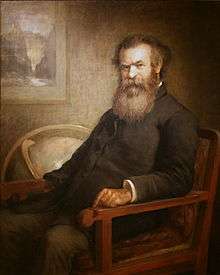 Powell as he appears at the National Portrait Gallery in Washington, D.C. | |
| 2nd Director of the United States Geological Survey | |
|
In office 1881 – 1894 | |
| Preceded by | Clarence King |
| Succeeded by | Charles Doolittle Walcott |
| Personal details | |
| Born |
March 24, 1834 Mount Morris, New York |
| Died |
September 23, 1902 (aged 68) Haven Colony, Brooklin, Maine |
| Resting place | Arlington National Cemetery, Section 1 |
| Nationality | American |
| Spouse(s) | Emma Dean Powell |
| Relatives | William B Powell, brother |
| Known for | Traversing Colorado River of the Grand Canyon |
| Education | |
| Scientific career | |
| Fields | Natural sciences |
| Institutions | |
| Military career | |
| Allegiance | United States of America |
| Service/ | United States Army |
| Years of service | 1861–1865 |
| Rank | Major |
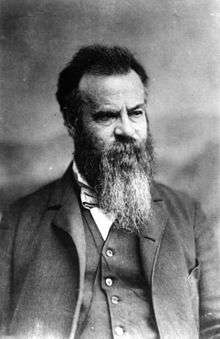
John Wesley Powell (March 24, 1834 – September 23, 1902) was a U.S. soldier, geologist, explorer of the American West, professor at Illinois Wesleyan University, and director of major scientific and cultural institutions. He is famous for the 1869 Powell Geographic Expedition, a three-month river trip down the Green and Colorado rivers, including the first official U.S. government-sponsored passage through the Grand Canyon.
Powell served as second director of the U.S. Geological Survey (1881–1894) and proposed, for development of the arid West, policies that were prescient for his accurate evaluation of conditions. He became the first director of the Bureau of Ethnology at the Smithsonian Institution during his service as director of the U.S. Geological Survey,[1] where he supported linguistic and sociological research and publications.
Biography
Early life
Powell was born in Mount Morris, New York, in 1834, the son of Joseph and Mary Powell. His father, a poor itinerant preacher, had emigrated to the U.S. from Shrewsbury, England, in 1830. His family moved westward to Jackson, Ohio, then Walworth County, Wisconsin, before settling in rural Boone County, Illinois.[2]
As a young man he undertook a series of adventures through the Mississippi River valley. In 1855, he spent four months walking across Wisconsin. During 1856, he rowed the Mississippi from St. Anthony, Minnesota, to the sea. In 1857, he rowed down the Ohio River from Pittsburgh to the Mississippi River, traveling north to reach St. Louis. In 1858 he rowed down the Illinois River, then up the Mississippi and the Des Moines River to central Iowa. At age 25, he was elected in 1859 to the Illinois Natural History Society.

Education
Powell studied at Illinois College, Illinois Institute (which would later become Wheaton College), and Oberlin College, over a period of seven years while teaching, but was unable to attain his degree.[3] During his studies Powell acquired a knowledge of Ancient Greek and Latin. Powell had a restless nature and a deep interest in the natural sciences. This desire to learn about natural sciences was against the wishes of his father, yet Powell was still determined to do so.[3] In 1860 when Powell was on a lecture tour he decided that the Civil War was inevitable; he decided to study military science and engineering to prepare himself for the imminent conflict.[3]
Civil war and aftermath
Powell's loyalties remained with the Union and the cause of abolishing slavery. On May 8, 1861, he enlisted at Hennepin, Illinois, as a private in the 20th Illinois Infantry. He was described as "age 27, height 5' 6-1/2" tall, light complected, gray eyes, auburn hair, occupation—teacher." He was elected sergeant-major of the regiment, and when the 20th Illinois was mustered into the Federal service a month later, Powell was commissioned a second lieutenant. He enlisted in the Union Army as a cartographer, topographer and military engineer.[4]
During the Civil War, he served first with the 20th Illinois Volunteers. While stationed at Cape Girardeau, Missouri, he recruited an artillery company that became Battery "F" of the 2nd Illinois Light Artillery with Powell as captain. On November 28, 1861, Powell took a brief leave to marry the former Emma Dean.[5] At the Battle of Shiloh, he lost most of his right arm when struck by a minie ball while in the process of giving the order to fire.[3] The raw nerve endings in his arm would continue to cause him pain for the rest of his life.
Despite the loss of an arm, he returned to the Army and was present at Champion Hill, Big Black River Bridge on the Big Black River and in the siege of Vicksburg. Always the geologist he took to studying rocks while in the trenches at Vicksburg.[6] He was made a major and commanded an artillery brigade with the 17th Army Corps during the Atlanta Campaign. After the fall of Atlanta he was transferred to George H. Thomas' army and participated in the battle of Nashville. At the end of the war he was made a brevet lieutenant colonel, but preferred to use the title of "Major".[6]
After leaving the Army, Powell took the post of professor of geology at Illinois Wesleyan University. He also lectured at Illinois State Normal University for most of his career. Powell helped expand the collections of the Museum of the Illinois State Natural History Society, where he served as curator. He declined a permanent appointment in favor of exploration of the American West.[7][8]
Geologic research
Expeditions
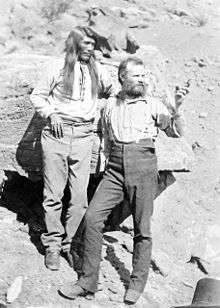
After 1867, Powell led a series of expeditions into the Rocky Mountains and around the Green and Colorado rivers. One of these expeditions was with his students and his wife, to collect specimens all over Colorado.[3] Powell, William Byers, and five other men were the first white men to climb Longs Peak in Colorado in 1868.[9]
In 1869, he set out to explore the Colorado River and the Grand Canyon. Gathering nine men, four boats and food for 10 months, he set out from Green River, Wyoming, on May 24. Passing through dangerous rapids, the group passed down the Green River to its confluence with the Colorado River (then also known as the Grand River upriver from the junction), near present-day Moab, Utah, and completed the journey on August 30, 1869.[8]
Members of the first Powell expedition:
- John Wesley Powell, trip organizer and leader, major in the Civil War;
- John Colton "Jack" Sumner, hunter, trapper, soldier in the Civil War;
- William H. Dunn, hunter, trapper from Colorado;
- Walter H. Powell, captain in the Civil War;
- George Y. Bradley, lieutenant in the Civil War, expedition chronicler;
- Oramel G. Howland, printer, editor, hunter;
- Seneca Howland;
- Frank Goodman, Englishman, adventurer;
- W. R. Hawkins, cook, soldier in Civil War;
- Andrew Hall, Scotsman, the youngest of the expedition;
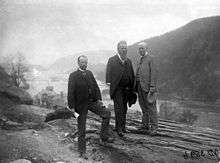
The expedition's route traveled through the Utah canyons of the Colorado River, which Powell described in his published diary as having
. . . wonderful features—carved walls, royal arches, glens, alcove gulches, mounds and monuments. From which of these features shall we select a name? We decide to call it Glen Canyon.
One man (Goodman) quit after the first month, and another three (Dunn and the Howland brothers) left at Separation Canyon in the third. This was just two days before the group reached the mouth of the Virgin River on August 30, after traversing almost 930 mi (1,500 km). The latter three disappeared; some historians have speculated they were killed by the Shivwitz band of the Southern Paiute.[10][11][12]
Powell retraced part of the 1869 route in 1871–1872 with another expedition that traveled the Colorado River from Green River, Wyoming to Kanab Creek in the Grand Canyon.[13] This trip resulted in photographs (by John K. Hillers), an accurate map and various papers. At least one Powell scholar, Otis R. Marston, noted the maps produced from the survey were impressionistic rather than precise.[14] In planning this expedition, he employed the services of Jacob Hamblin, a Mormon missionary in southern Utah and northern Arizona, who had cultivated excellent relationships with Native Americans. Before setting out, Powell used Hamblin as a negotiator to ensure the safety of his expedition from local Indian groups.
After the Colorado
In 1874, the intellectual gatherings Powell hosted in his home were formalized as the Cosmos Club.[15] The club has continued, with members elected to the club for their contributions to scholarship and civic activism.
In 1881, Powell was appointed the second director of the U.S. Geological Survey,[16] a post he held until his resignation in 1894,[17] being replaced by Charles Walcott.
In 1875, Powell published a book based on his explorations of the Colorado, originally titled Report of the Exploration of the Columbia River of the West and Its Tributaries. It was revised and reissued in 1895 as The Exploration of the Colorado River and Its Canyons.
In the early 1900s the journals of the crew began to be published starting with Dellenbaugh's "A Canyon Voyage" in 1908, followed by the Thompson diary in 1939.[3] Finally Bishop, Steward, W. C. Powell, and Jones' diaries were all published in 1947.[3] These diaries made it clear Powell's writings contained some exaggerations and recounted activities that occurred on the second river trip as if they occurred on the first. They also revealed that Powell, who had only one arm, utilized a life jacket, though the other men did not have them.[18]
Anthropologic research
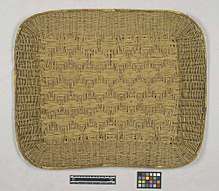
Powell became the director of the Bureau of Ethnology at the Smithsonian Institution in 1879 and remained so until his death.[10] Under his leadership, the Smithsonian published an influential classification of North American Indian languages.[19] In 1898, Powell was elected a member of the American Antiquarian Society.
As an ethnologist and early anthropologist, Powell was a follower of Lewis Henry Morgan.[20] He classified human societies into "savagery," "barbarism" and "civilization".[21] Powell's criteria were based on consideration of adoption of technology, family and social organization, property relations, and intellectual development. In his view, all societies were to progress toward civilization. Powell is credited with coining the word "acculturation", first using it in an 1880 report by the U.S. Bureau of American Ethnography. In 1883, Powell defined "acculturation" as psychological changes induced by cross-cultural imitation.
Powell published extensive anthropological studies on the Ute people inhabiting the canyon lands around the Colorado River. His views towards these populations, along with his scientific approach, was built on social Darwinist thought; he focused on defining what features distinguished Native Americans as 'barbaric', placing them above 'savagery' but below 'civilized' white Europeans.[22] Indeed the study of ethnology was a way for scientist to demarcate social categories in order to justify government-sponsored programs that exploited newly adopted land and its inhabitants.[23][22][24] Powell advocated for government funding to be used to 'civilize' Native American populations, pushing for the teaching of English, Christianity, and Western methods of farming and manufacture.[25][26]
In his book The Exploration of the Canyons of the Colorado, Powell is motivated to conduct ethnologic studies because "these Indians are more nearly in their primate condition than any others on the continent with whom I am acquainted."[25] As Wallace Stegner posits in Beyond the 100th Meridian, by 1869, many Native American tribes had been pushed to extinction, and those that were known were considered corrupted by intercultural exchange.[10] Even in 1939, Julian Steward, an anthropologist compiling photographs from Powell's 1873 expedition suggested that: "Fascinated at finding [Native Americans] nearly untouched by civilization, he developed a deep interest in ethnology … Few explorers in the United States have had a comparable opportunity to study and photography Indians so nearly in their aboriginal state." [27]
Powell created Illinois State University's first Museum of Anthropology which at the time was called the finest in all of North America.[28]
Powell held a post as Lecturer on the History of Culture in the Political Science department at the Columbian University in Washington, DC from 1894-1899.[29]
Environmentalism
In Cadillac Desert, Powell is portrayed as a champion of land preservation and conservation.[30] Powell's expeditions led to his belief that the arid West was not suitable for agricultural development, except for about 2% of the lands that were near water sources. His Report on the Lands of the Arid Regions of the United States proposed irrigation systems and state boundaries based on watershed areas to avoid disagreements between states.[31] For the remaining lands, he proposed conservation and low-density, open grazing.[20]
The railroad companies, who owned vast tracts of lands 183,000,000 acres (740,000 km2) granted in return for building the railways, did not agree with Powell's views on land conservation. They aggressively lobbied Congress to reject Powell's policy proposals and to encourage farming instead, as they wanted to cash in on their lands. The U.S. Congress went along and developed legislation that encouraged pioneer settlement of the American West based on agricultural use of land. Politicians based their decisions on a theory of Professor Cyrus Thomas who was a protege of Horace Greeley. Thomas suggested that agricultural development of land would change climate and cause higher amounts of precipitations, claiming that "rain follows the plow", a theory which has since been largely discredited.
At an 1883 irrigation conference, Powell would prophetically remark: "Gentlemen, you are piling up a heritage of conflict and litigation over water rights, for there is not sufficient water to supply the land."[32] Powell's recommendations for development of the West were largely ignored until after the Dust Bowl of the 1920s and 1930s, resulting in untold suffering associated with pioneer subsistence farms that failed due to insufficient rain and water.
Legacy
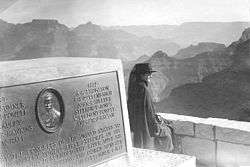
- In recognition of his national service, Powell was buried in Arlington National Cemetery,[33] Virginia.
- The rare mineral powellite was named after him.
- Green River, Wyoming, the embarkation site of both Powell expeditions commissioned a 9 1/2-foot tall portrait of Powell holding an oar, which now stands in front of the Sweetwater County History Museum.
- Lake Powell, a man-made reservoir on the Colorado River, was named for Powell.
- He is the namesake of Powell Peak.[34]
- Powell Plateau, near Steamboat Mountain on the North Rim of the Grand Canyon was also named in his honor.
- Powell, Wyoming Major Powell never explored the Powell flats given his name.[35]
- In Powell's honor, the USGS National Center in Reston, Virginia, was dedicated as the John Wesley Powell Federal Building in 1974. In addition, the highest award presented by the USGS to persons outside the federal government is named the John Wesley Powell Award.
- The residential building of the Criminal Justice Services Department of Mesa County in Grand Junction, Colorado, is named after John Wesley Powell.[36]
- John Wesley Powell Middle School is located in Littleton, Colorado.[37]
- Powell Jr High School is located in Mesa, Arizona.
- He was portrayed by John Beal in the 1960 film Ten Who Dared.
- Powell is the subject of the Ozark Mountain Daredevils song "Mr. Powell", which is on The Car Over the Lake Album[38]
References
- ↑ Hunter, Cathy. "John Wesley Powell: Soldier, Explorer, Scientist and National Geographic Founder". National Geographic. Retrieved 5 December 2014.
- ↑ Worster 2001, pp. 3–51.
- 1 2 3 4 5 6 7 USGS."John Wesley Powell: soldier, explorer, scientist." USGS: Science for a Changing World. Last modified March 28, 2006. Accessed February 20, 2014.
- ↑ Weiner, Americans Without Law (New York University Press, 2006).
- ↑ Worster 2001, p. 89.
- 1 2 USGS: John Wesley Powell
- ↑ Kemp, Bill (January 17, 2009). "'Conqueror of the Grand Canyon' returned to Bloomington in 1896". The Pantagraph. Archived from the original on January 31, 2013. Retrieved January 17, 2009.
- 1 2 "The Beginnings of the U.S. Geological Survey". National Atlas of the United States. 2010. Archived from the original on October 24, 2012. Retrieved October 9, 2010.
- ↑ National Park Service (1919). General Information Regarding Rocky Mountain National Park. U.S. Government Printing Office. p. 35.
- 1 2 3 Stegner, Wallace (1954). Beyond the Hundredth Meridian: John Wesley Powell and the Second Opening of the West, University of Nebraska Press. ISBN 0-8032-4133-X (and other reprint editions). p. 239-240
- ↑ "Utah Lighthouse Ministry". Retrieved 2015-01-28.
- ↑ Krakauer, Jon (2004). Under the Banner of Heaven: A Story of Violent Faith, Knopf Doubleday Publishing, p. 243 ISBN 9781400078998
- ↑ Marston, Otis R., (2014). "From Powell To Power; A Recounting of the First One Hundred River Runners Through the Grand Canyon. Flagstaff, Arizona: Vishnu Temple Press, p. 111-114 ISBN 978-0990527022
- ↑ Marston, Otis R., (2014). "From Powell To Power; A Recounting of the First One Hundred River Runners Through the Grand Canyon. Flagstaff, Arizona: Vishnu Temple Press, p. 114 ISBN 978-0990527022
- ↑ Worster 2001, pp. 437–439.
- ↑ Worster 2001, p. 394.
- ↑ Worster 2001, p. 534.
- ↑ Marston, Otis R., (2014). "From Powell To Power; A Recounting of the First One Hundred River Runners Through the Grand Canyon. Flagstaff, Arizona: Vishnu Temple Press, p. 48, 50-51, 53, 55, 57, 59, 63, 93, 107 ISBN 978-0990527022
- ↑ Reprinted in Boas and Powell, infra.
- 1 2 Worster 2001.
- ↑ John S. Haller (1971). Outcasts from Evolution: Scientific Attitudes of Racial Inferiority, 1859-1900. SIU Press. p. 108. ISBN 978-0-8093-1982-4. Retrieved 2 March 2013.
- 1 2 Baker, Lee D. (1998). From Savage to Negro Anthropology and the Construction of Race, 1896-1954. University of California Press.
- ↑ Haller, John S. (1971). "Race and the Concept of Progress in Nineteenth Century American Ethnology". American Anthropologist. 73 (3): 710–724. JSTOR 671764.
- ↑ Powell, J. W. (1888). "From Barbarism to Civilization". American Anthropologist. 1 (2): 97–123. JSTOR 658712.
- 1 2 Powell, John Wesley (1895). Exploration of the Canyons of the Colorado. New York: Dover Publications.
- ↑ Powell, Ingalls, J.W., G.W. (1875). Report of special commissioners J. W. Powell and G. W. Ingalls on the condition of the Ute Indians of Utah; the Pai-Utes of Utah, northern Arizona, southern Nevada, and southeastern California; the Go-si Utes of Utah and Nevada; the northwestern Shoshones of Idaho and Utah; and the western Shoshones of Nevada; and report concerning claims of settlers in the Mo-a-pa valley (southeastern Nevada). Washington, D.C.: United States. Bureau of Indian affairs.
- ↑ Steward, Julian H. (1939). Notes on Hillers' photographs of the Paiute and Ute Indians taken on the Powell expedition of 1873 by Julian H. Steward, with 31 plates. City of Washington, The Smithsonian institution.
- ↑ Powell, John Wesley, and William Eno DeBuys. Seeing Things Whole: The Essential John Wesley Powell. Washington, DC: Island Press/Shearwater Books, 2001.
- ↑ "Catalogue of the Columbian College in the District of Columbia. 1898-1901". HathiTrust. Retrieved 2018-06-09.
- ↑ Reisner, Marc (1993). Cadillac Desert: The American West and Its Disappearing Water. Penguin.
- ↑ John Wesley Powell. Report on the Lands of the Arid Region of the United States, With a More Detailed Account of the Lands of Utah. Cambridge: Harvard University Press, 1962.
- ↑ Michael Hiltzik (2010-07-05). "The false promise of Hoover Dam". LA Times. Retrieved 2010-07-06.
- ↑ Worster 2001, p. 570.
- ↑ Dziezynski, James (1 August 2012). Best Summit Hikes in Colorado: An Opinionated Guide to 50+ Ascents of Classic and Little-Known Peaks from 8,144 to 14,433 Feet. Wilderness Press. p. 140. ISBN 978-0-89997-713-3.
- ↑ http://www.cityofpowell.com/assets/pages/community/aboutpowell.aspx
- ↑ "Archived copy". Archived from the original on March 7, 2013. Retrieved 2012-11-16.
- ↑ http://powell.littletonpublicschools.net/
- ↑ Schiefelbein, David (10 August 2012). "The Colorado Road Trip Playlist". The Chaffee County Times. Retrieved 13 October 2014.
- ↑ IPNI. J.W.Powell.
Sources
- Powell, J. W. (1875). The Exploration of the Colorado River and Its Canyons. New York: Dover Press. ISBN 0-486-20094-9 (and other reprint editions).
- Aton, James M. (2010). John Wesley Powell: His Life and Legacy. ISBN 978-0-87480-992-3
- Boas, F.; Powell, J. W. (1991) Introduction to Handbook of American Indian Languages plus Indian Linguistic Families of America North of Mexico, University of Nebraska Press, ISBN 0-8032-5017-7
- Darrah, William Culp, Ralph V. Chamberlin, and Charles Kelly. (2009). The Exploration of the Colorado River in 1869 and 1871–1872: Biographical Sketches and Original Documents of the First Powell Expedition of 1869 and the Second Powell Expedition of 1871–1872. University of Utah Press. ISBN 978-0-87480-963-3.
- Dolnick, Edward (2002). Down the Great Unknown : John Wesley Powell's 1869 Journey of Discovery and Tragedy Through the Grand Canyon (Paperback). Harper Perennial. ISBN 0-06-095586-4.
- Dolnick, Edward (2001). Down the Great Unknown : John Wesley Powell's 1869 Journey of Discovery and Tragedy Through the Grand Canyon (Hardcover). HarperCollins Publishers. ISBN 0-06-019619-X.
- Ghiglieri, Michael P., Bradley, George Y. (2003). First Through Grand Canyon: The Secret Journals & Letters of the 1869 Crew Who Explored the Green and Colorado Rivers (Paperback). Puma Press . ISBN 0-9700973-2-8.
- Judd, Neil Merton. The Bureau of American Ethnology; a partial history. Norman: University of Oklahoma Press, 1967.
- Marston, Otis R., (2014). "From Powell To Power; A Recounting of the First One Hundred River Runners Through the Grand Canyon. Flagstaff, Arizona: Vishnu Temple Press, p. 111-114 ISBN 978-0990527022
- National Geographic Society (1999) Exploring the Great Rivers of North America. ISBN 0-7922-7846-1.
- Reisner, Marc (1993). Cadillac Desert: The American West and Its Disappearing Water (Paperback). Penguin Books. ISBN 0-14-017824-4.
- Stegner, Wallace (1954). Beyond the Hundredth Meridian: John Wesley Powell and the Second Opening of the West. University of Nebraska Press. ISBN 0-8032-4133-X (and other reprint editions).
- Weiner, Mark S (2006). Americans Without Law. New York University Press. ISBN 0-8147-9364-9.
- Worster, Donald (2001). A River Running West: The Life of John Wesley Powell. Oxford University Press. ISBN 0-19-509991-5.
- Reisner, Marc (1986). "Cadillac Desert: the American West and its Disappearing Water".
- Powell, J.W. (1876). A Report on the Arid Regions of the United States, with a More Detailed Account of the Lands of Utah"
- USGS."John Wesley Powell: soldier, explorer, scientist." USGS: Science for a Changing World. Last modified March 28, 2006. Accessed February 20, 2014. https://web.archive.org/web/20110316120346/http://www.cr.nps.gov/history/online_books/geology/publications/inf/74-24/index.htm
External links
| Wikimedia Commons has media related to John Wesley Powell. |
| Wikisource has original works written by or about: John Wesley Powell |
- Biographical sketch (1903) by Frederick S. Dellenbaugh
- NPS John Wesley Powell Photograph Index
- Works by John Wesley Powell at Project Gutenberg
- Works by or about John Wesley Powell at Internet Archive
- Works by John Wesley Powell at LibriVox (public domain audiobooks)

- John Wesley Powell Student Research Conference at Illinois Wesleyan University
- John Wesley Powell Collection of Pueblo Pottery at Illinois Wesleyan University Ames Library
- Powell Museum, Page, Arizona
- John Wesley Powell River History Museum, Green River, Utah
- "John Wesley Powell" by James M. Aton in the Western Writers Series Digital Editions at Boise State University
- "A Canyon Voyage, The Narrative of the Second Powell Expedition down the Green-Colorado River from Wyoming, and the Explorations on Land, in the Years 1871 and 1872" (1908) by Frederick Samuel Dellenbaugh at Project Gutenberg.
- John Wesley Powell — Biographical Memoirs of the National Academy of Sciences
- Powell, J. W., In Fowler, D. D., & In Fowler, C. S. (1971). Anthropology of the Numa: John Wesley Powell's manuscripts on the Numic peoples of Western North America, 1868-1880. Washington: Smithsonian Institution Press; for sale by the Supt. of Docs., U.S. Govt. Print. Off..
- Fowler, D. D., Matley, J. F., & National Museum of Natural History (U.S.). (1979). Material culture of the Numa: The John Wesley Powell Collection, 1867-1880. Washington: Smithsonian Institution Press.
- John Wesley Powell artifact collections in the Department of Anthropology, National Museum of Natural History, Smithsonian Institution.
| Preceded by Clarence King |
Director of the United States Geological Survey 1881–1894 |
Succeeded by Charles Doolittle Walcott |
